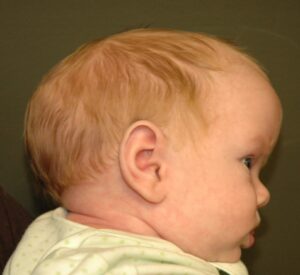
What is it?
The sagittal suture is a skull expansion joint running from the front of the skull to the rear (shown in red in the image below). Sagittal synostosis is a condition when that expansion joint fuses too early. When this occurs, the skull cannot widen the way it should as the brain grows. This leads to an abnormally elongated skull shape.
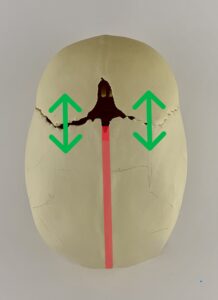
What to look for?
The skull becomes elongated and narrow front to back, the forehead becomes too rounded, and the posterior skull can appear too pointed or coned. When viewed from the side, the skull also slopes downward front to back.
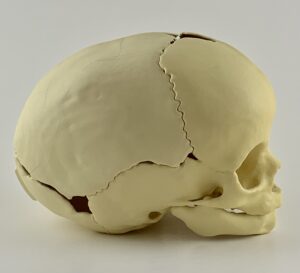
Why is surgery recommended?
When the skull cannot grow the way it should, it becomes progressively abnormal in appearance. Sometimes, intracranial pressure can become elevated. Surgery is recommended to normalize appearance, limit negative social interactions and reduce the risk of developmental concerns from elevated pressure.
Before and After Cranioplasty Surgery
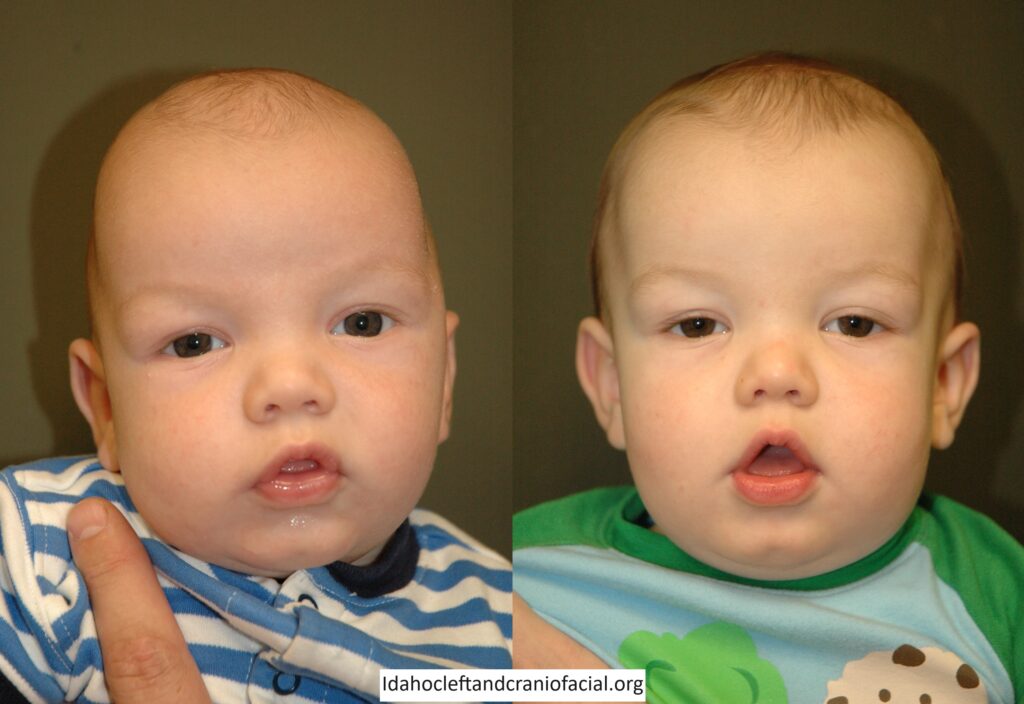
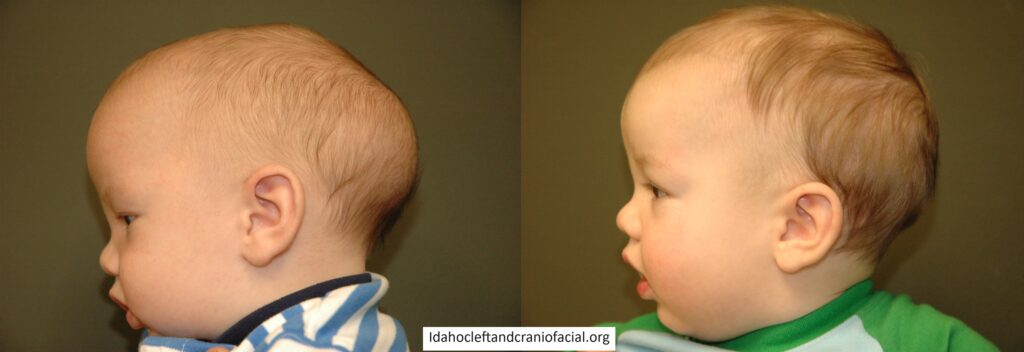
Frequently Asked Questions
The skull sutures can be thought of as expansion joints. These expansion joints play a critical role in allowing the skull to grow quickly when the brain is growing rapidly in the first 12 to 18 months of life. When one of these expansion joints fuses, this restricts growth in the direction perpendicular to the suture. When the sagittal suture, which runs down the middle of the skull from front to back, is involved, the skull cannot grow side-to-side as it wants to. But the brain is resilient and will find a way to grow, usually pushing the skull forward and backward. This results in the characteristic frontal bossing and the elongated tapering appearance of the skull as it flows towards the back.
There are 2 surgical approaches to treating sagittal craniosynostosis – a minimally invasive approach and a traditional open surgical approach. For infants who are less than 5 months of age whose skull bones are very soft, we can use a minimally invasive approach. With minimally invasive surgery, small incisions are made at several key points along the top of the scalp. Working through those small incisions, the fused sagittal suture is removed. Working through the small incisions, a craniofacial plastic surgeon then makes additional cuts in the skull bones to reshape the areas that are most narrowed and constricted. We then use a postoperative molding helmet to fine-tune the head shape for a few months. For children who are older than 5 months whose bones are more dense, a traditional open approach is often required. With the traditional open approach, an incision is made over the top of the scalp from one ear to the other. Markings are then made for removal of the skull bones in the areas of concern, and a craniofacial plastic surgeon then re-shapes and reconstructs the skull to give an immediate improvement in the skull shape. While this surgery is a bigger operation, there is no need for molding helmet therapy after surgery in most cases.
The craniofacial plastic surgeon has specialized training in reconstructing and reshaping the skull and facial bones. The primary role of the craniofacial plastic surgeon is to assess the skull shape, determine the best way to normalize the shape and then perform the reconstruction to ensure the desired final result.
While it is the craniofacial plastic surgeon’s ultimate responsibility to reconstruct the head shape and give an excellent end result, it is also important to ensure that the fused suture and deformed skull bone be removed safely, taking care to protect the underlying brain and dura, the lining around the brain. For this reason, we always partner with a pediatric neurosurgeon whose primary role is to protect the brain and ensure the safe removal of bone to facilitate craniofacial surgeon’s reconstruction.
For over 25 years, we have been loyal partners of St. Luke’s Children’s Hospital in Boise, Idaho in caring for children with complex pediatric cleft and craniofacial problems. We have always felt that pediatric surgical care should be offered in the setting where dedicated, fellowship trained pediatric anesthesia specialists are available to ensure the safest possible surgery for the children that we care for.
The timing of surgery for craniosynostosis can vary depending on how old your child is at the time of diagnosis, their overall health and the surgical approach selected by you and your craniofacial surgeon. If your child is healthy and is diagnosed at an early age (in the first 2-3 months of life), then minimally invasive surgery can often be done between 2-5 months of age. If your child is diagnosed at a later age (after 5 months), needs an open surgical approach or has health concerns that require waiting to perform surgery until they are older, your child’s surgery may be done closer 6-12 months of age.
We recommend you carefully do your homework in choosing your surgeon. Just because the medical center has a big name does not mean their employed craniofacial surgeon does things well or has a lot of experience. First, you should ask your surgeon how much experience they have, how long they have been in practice and how often they do synostosis surgery. You should also ask your surgeon to see lots of enlarged, clearly focused, before and after pictures not only right after synostosis surgery but several years later. You can also ask your surgeon for referrals from other patients he or she has operated upon so you can talk to them directly to assess their results and overall experience.
After surgery, we watch your child overnight in the pediatric intensive care unit. This is not because we expect your child will be sick or unstable but because the ICU provides the most attentive care to be sure your child is doing well as they recover from surgery. The morning after surgery, your child will likely transfer out of the ICU to a normal pediatric hospital bed. You will get to go home when your child’s pain is controlled, swelling has started to resolve, they are eating well and your family feels ready. When minimally invasive surgery is done, your child will likely go home 1-2 days after their procedure. For open surgeries, your child will likely go home 2-3 days after their procedure.
Postoperative complications are extremely rare utilizing our team’s protocol. There is a small risk of bleeding after surgery that may require a blood transfusion. Because our patients are small, even a little bit of bleeding can require that we give some blood back. We will check some labs several times in the first 24 hours after surgery to be sure that everything looks good. When operating around the brain, there is also a risk of injuries to the brain or the lining tissue around the brain. This is why we always work with our pediatric neurosurgeon partners for the bone removal phase of surgery. The neurosurgeons are experts at removing skull bones safely, helping us make sure to keep your child safe. More common problems after surgery include occasional nausea and irritability and swelling of the scalp and around the eyes. These problems generally resolve quickly in the first few days after surgery.
Our excellent results are attributed to proper patient preparation, expert completion of the surgery, and careful postoperative management management by both the hospital providers and the family at home.
It generally takes about 6 weeks for the skull bones to be solid and strong after synostosis surgery. At that point, you should be able to care for your child normally, without a lot of special precautions. However, although the skull is strong and your child is safe, there may still be some small “soft spots” that will continue to fill-in with new bone over a year or two. That is normal, and you can expect to see those soft spots slowly decrease in size with time.
Generally, children who have sagittal synostosis are completely normal kids who just happen to have a fused skull suture. After corrective surgery by a craniofacial surgeon, you can expect the skull bones to heal solidly and your child to be able to participate in normal activities, including sports or any other activities they enjoy. There should not be any limitations.
